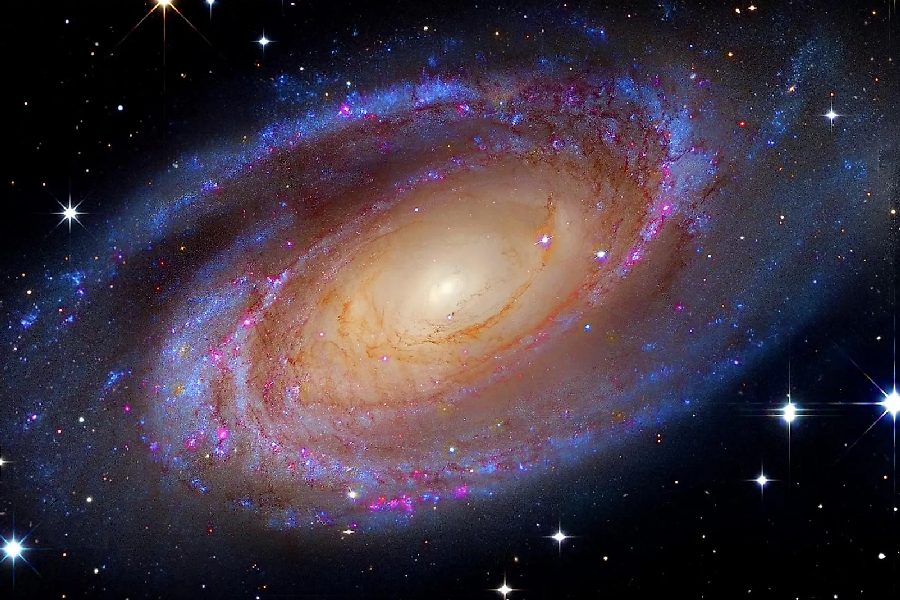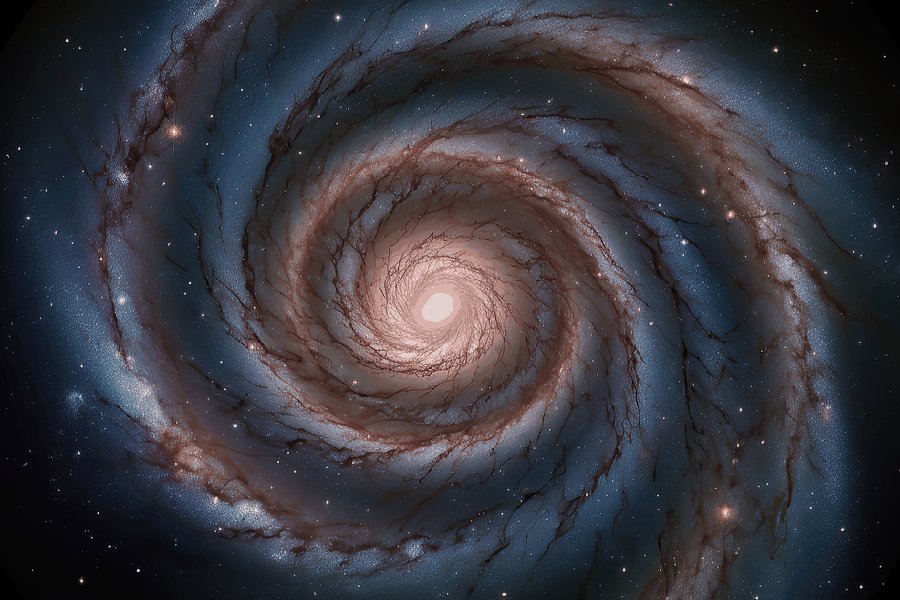Looking up at the night sky, the Milky Way galaxy appears as a faint, cloudy band stretching across the heavens. But how big is the Milky Way?
Let’s delve into the structure and parts that form our spiral galaxy. Even though it’s challenging, we’ll explore how astronomers measure its size. They’ve devised ways to estimate the Milky Way’s size, and we’ll discuss the galactic center, spiral arms, halo, and more, spanning over 100,000 light-years.
Without any further ado, let’s get started!

About the Milky Way
The Milky Way galaxy is a vast spiral galaxy containing more than 100 billion stars. In the Milky Way’s core, a supermassive black hole is surrounded by a dense group of stars known as the galactic bulge.
The galactic disk is extended outward from this central region, a wide expanse where the spiral arms, shaping our galaxy with their winding patterns, can be found. The stellar halo encircles it, housing some of the oldest stars in our galaxy. These elements and a vast amount of dark matter contribute to the Milky Way’s overall dimensions.
Furthermore, one of the galaxies comparable in size is the Andromeda Galaxy, our nearest large galactic neighbor positioned 2.5 million light-years away from Earth. Regarding the breadth of the Milky Way, our Solar System is located about two-thirds of the way from the central bulge, at a distance of approximately 25,000 light-years from the galactic core region.
The importance of understanding the size and structure
Understanding the size of our galaxy allows us to chart stars, gas, and dust over immense distances. Once we grasp the spiral structure, it becomes clear where our Solar System is positioned in the galactic disk.
Additionally, blending information about size and structure gives us a more comprehensive view of how our stellar neighborhood rotates and orbits within the entire galaxy. Precise measurements provide valuable insights into theories about the Milky Way’s origin, development, distribution of mass, and the composition of dark matter.
How Big Is the Milky Way in Light Years?
The Milky Way is a barred spiral galaxy categorized as SBc type. It measures approximately 150,000 to 180,000 light-years across. This makes it broader than the Andromeda Galaxy.
But how big is the Milky Way in diameter? Estimating an exact width and breadth is challenging, but the galactic disk has a diameter between 100,000 to 120,000 light-years. This stretches from the central bar and bulge region to the outer stellar disk. The total stellar mass equals 700 billion to 1 trillion solar masses.
Moreover, the structure can be described as concentric rings orbiting the core, with arms of newer stars spanning out. Our Solar System resides near the inner edge of the Orion Arm. While dense, the Orion Arm spans only 3,500 light-years at its widest point.
In the grand scheme of the Milky Way, our Solar System is approximately 25,000 light-years away from the center. It’s like a speck in a vast space. Our neighborhood takes about 225 to 250 million years to complete a single orbit around the Milky Way, moving at a staggering speed of 450,000 miles per hour.
Size in Comparison to Other Galaxies
The Milky Way stands out as a big galaxy compared to others. But how big is the Milky Way compared to other galaxies? It’s broader than nearby galaxies and has more mass than dwarf types.
The Andromeda Galaxy is the closest one in size to ours. Andromeda is a bit larger, stretching across 220,000 light-years. When we consider both the Milky Way and Andromeda, they dominate the Local Group.
However, beyond our galactic neighborhood, there are even larger galaxies. Giant elliptical and cD types can reach over 2 million light-years across. So, although the Milky Way is sizable, it appears modest compared to these true galactic giants.
Spiral galaxies
Spiral galaxies have a distinct structure, including a flat, rotating disk, central bulge, and halo. In the disk, spiral arms extend outward from the core, consisting of young stars, gas, and dust clouds.
Our galaxy, the Milky Way, neatly falls into the spiral category. It showcases prominent arms that stretch out from its central bar. Orbiting around this bar is a stellar bulge, a characteristic feature in spiral galaxies.
With their unique features, spiral galaxies are widespread in the observable universe. Astronomers classify them based on characteristics such as the shape of their arms, the prominence of the bulge, and how tightly the arms are wound.

Globular clusters
Globular clusters, tightly packed groups of stars held together by gravity, play a crucial role in understanding our galaxy. Numbering over 150, these clusters orbit the Milky Way, extending beyond its galactic plane. Made up of ancient, low-metal stars from the earliest periods, they serve as valuable remnants of our galaxy’s early history.
As we explore these globular clusters, we find that their density increases as we move closer to the galactic bulge and core. These clusters, acting as satellites within the galactic haloes, have significantly contributed to mapping the extent of our galaxy.
Moreover, globular clusters have been instrumental in determining the dimensions of the Milky Way. Researchers unveiled the vast halo surrounding our galaxy by studying some of the most distant clusters. This discovery greatly enhanced our overall understanding of the Milky Way’s structure.
Island universes
In the early 20th century, there were discussions about the nature of observed nebulae. Scientists were trying to determine whether these cloudy formations were part of our galaxy or separate “islands” in space. Eventually, the idea of external galaxies was proven to be true.
As technology advanced, scientists were able to make more precise observations, especially regarding the distances to nebulae. Edwin Hubble played a crucial role in this progress.
His research showed that Andromeda, one of the nebulae, existed far beyond the outer limits of the Milky Way. This discovery settled the debate about the existence of extragalactic entities.
In the present day, our understanding has expanded significantly. Modern estimates indicate that hundreds of billions to trillions of galaxies are scattered throughout the observable universe.
That is, our Milky Way is just one large stellar island in the vastness of the cosmos. Exploring the diverse nature of galaxies and their evolutionary processes remains a key focus in astronomy.
Observable universe
The observable universe encompasses the distant galaxies detectable from Earth. It spans an estimated 93 billion light-years across. And countless galaxies beyond our view exist untouched.
The Milky Way is in the suburbs of the Virgo Supercluster, which holds thousands of galaxies in a sphere spanning 110 million light-years. Virgo orbits within the Laniakea Supercluster, extending over 520 million light-years. Even though our galaxy is located on an outer spiral arm and may not stand out, exploring the universe from our vantage point is a groundbreaking venture.
Measuring the Milky Way’s Size
Measuring the size of galaxies has been a tough task. In the 19th century, scientists faced challenges because they relied on hidden dust clouds for estimates.
However, progress in astrophysics introduced new ways to measure. Researchers could find rotational values by studying the speeds of stars and satellites in orbit.
Additionally, examining the locations of faraway globular clusters helped determine the width of the stellar halo. Bringing together various methods allowed scientists to model the complete dimensions. Yet, accurate measurements are still limited by the galaxy’s edge-on orientation and areas that are hard to study.
Distance to the galactic center and beyond
Our Solar System is 25,000 light-years from the center of our galaxy, the Milky Way, just beyond its inner hub. This is about one-third of the estimated 70,000-light-year radius of the Milky Way. In the central part of the galaxy, there is a concentration of aging star populations around a supermassive black hole.
However, the dense inner parsecs of the galaxy are not directly observable. If we traveled across the entire diameter of the Milky Way non-stop at the speed of light, which is quite challenging, it would take 180,000 years to make a one-way journey across our galaxy. Beyond this vast expanse are even greater empty spaces known as intergalactic voids.
Motions of Stars in Disk and Bulge
In the vast galactic disk, billions of stars move in orbits, each determined by its mass and distance from the center. Most stars cruise about 186 miles per second, completing a full revolution around the galactic center in over 200 million years.
At the galaxy’s heart lies the ancient central bulge, which dates back to the earliest epochs. Stars in this region move at speeds double those found in the outer disk. The integrated motions of these stars find a delicate balance with the concentrated inner mass.
This dynamic interplay involving stellar movements, gravitational forces, and angular energy unfolds over countless eons, giving rise to the spiral arms structure. As stars shift patterns, migrating between arms, they disrupt and renew the overall arrangement, creating an ever-changing cosmic dance.
Conclusion
How large is the Milky Way? We ventured from our Solar System, located 25,000 light-years away from the galaxy’s center, to its outer edges and even further into the expansive unknown. With hundreds of billions of stars scattered throughout this impressive barred spiral, our stellar island stands out by most standards.
Although exact measurements of the Milky Way’s size are still uncertain, this journey across various scales, from our immediate solar neighborhood to the galaxy’s vastness, highlights our pioneering efforts to understand our place in the universe.
